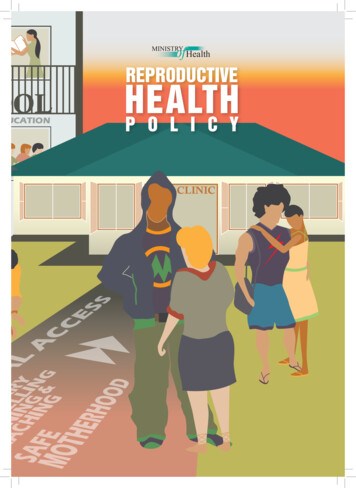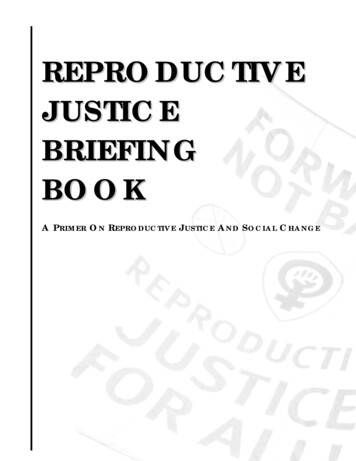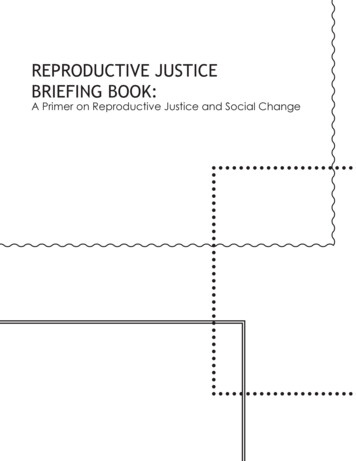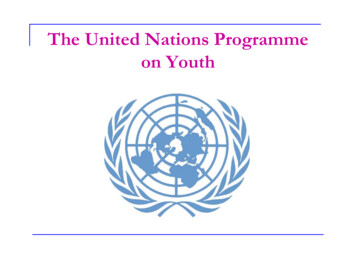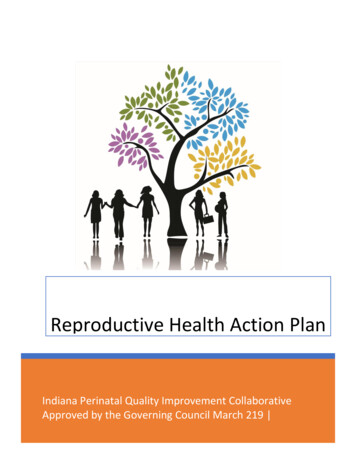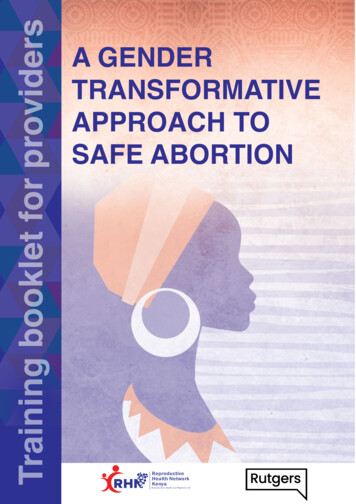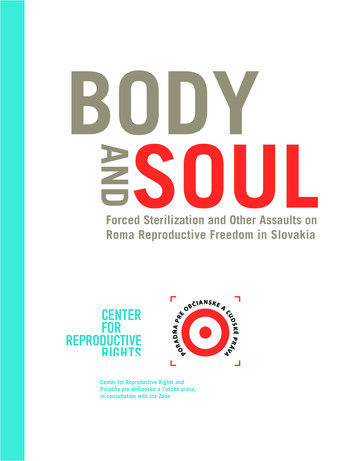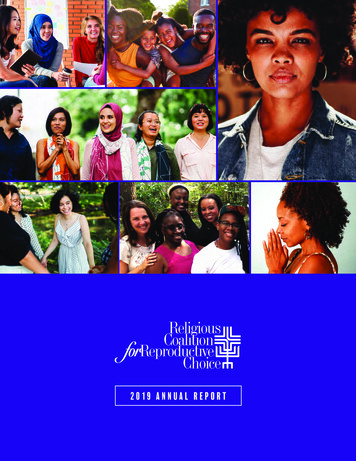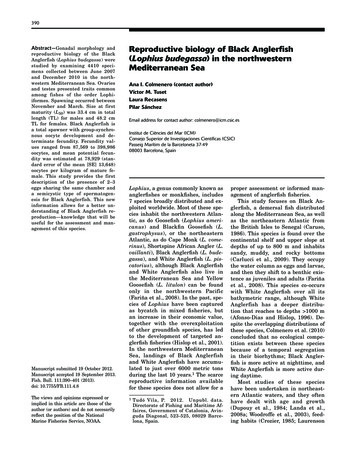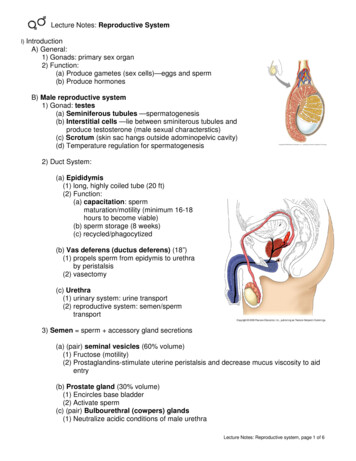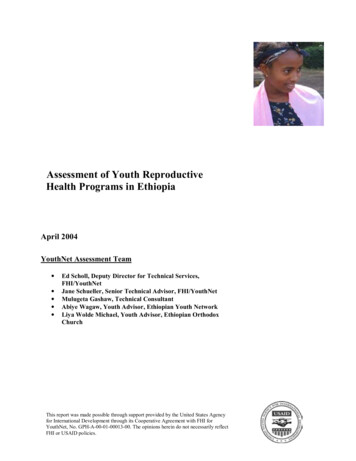
Transcription
Assessment of Youth ReproductiveHealth Programs in EthiopiaApril 2004YouthNet Assessment Team Ed Scholl, Deputy Director for Technical Services,FHI/YouthNetJane Schueller, Senior Technical Advisor, FHI/YouthNetMulugeta Gashaw, Technical ConsultantAbiye Wagaw, Youth Advisor, Ethiopian Youth NetworkLiya Wolde Michael, Youth Advisor, Ethiopian OrthodoxChurchThis report was made possible through support provided by the United States Agencyfor International Development through its Cooperative Agreement with FHI forYouthNet, No. GPH-A-00-01-00013-00. The opinions herein do not necessarily reflectFHI or USAID policies.
In July 2011, FHI became FHI 360.FHI 360 is a nonprofit human development organization dedicated to improving lives in lasting ways byadvancing integrated, locally driven solutions. Our staff includes experts in health, education, nutrition,environment, economic development, civil society, gender, youth, research and technology – creating aunique mix of capabilities to address today’s interrelated development challenges. FHI 360 serves morethan 60 countries, all 50 U.S. states and all U.S. territories.Visit us at www.fhi360.org.
ii
TABLE OF CONTENTSACRONYMS/ABBREVIATIONS . vI. EXECUTIVE SUMMARY . 1II. INTRODUCTION AND BACKGROUND. 2Youth Reproductive Health Data . 3HIV/AIDS in Ethiopia . 6III. YOUTHNET ASSESSMENT TEAM VISIT . 8About YouthNet . 8Assessment Team Methodology. 9IV. EXISTING PROGRAMS . 10Government Programs and Policies . 13NGO Programs . 14Private Commercial Sector . 16Donor Agencies . 17V. REPEATED THEMES . 18VI. POTENTIAL AREAS FOR YOUTHNET INVOLVEMENT . 22ANNEXES . . 26ANNEX 1: Youth Reproductive Health Summary. 27ANNEX 2: Organizations Visited and Individuals Interviewed . 29ANNEX 3: Illustrative Questions for In-Country Interviews. 31ANNEX 4: SWOT Analysis. 33ANNEX 5: Description of Organizations Visited. 37iii
iv
AMMOEMOHMYSCNFPNGONOPAbstain, Be faithful or use a CondomAmhara Development AssociationAfrica Humanitarian ActionAcquired Immune Deficiency SyndromeAdolescent reproductive healthAdolescent reproductive and sexual healthBehavior change communicationBehavioral Surveillance SurveyCommunity-based reproductive health agentConsortium of Reproductive Health AssociationsContraceptive Prevalence SurveyCommercial sex workerDepartment for International DevelopmentDemographic and Health SurveyGerman Foundation for World PopulationEmergency contraceptionEmergency contraceptive pillsEthiopian Evangelical Church Mekane YesusEthiopian Kale Hiwot ChurchEthiopian Muslim Development AgencyEthiopian Orthodox ChurchEssential Services for Health in EthiopiaEthiopian Society of Obstetricians and GynecologistsFaith-based organizationFamily Guidance Association of EthiopiaFemale genital cuttingFamily Health InternationalFamily life educationFiscal yearHIV/AIDS Prevention and Control OfficeHuman Immunodeficiency VirusInformation, education, and communicationImplementing partner organizationsInternational Planned Parenthood FederationIn-school youthIntrauterine deviceJapanese International Cooperation AgencyLactational amenorrhea methodMinistry of EducationMinistry of HealthMinistry of Youth, Sports, and CultureNatural family planningNon-governmental organizationNational Office of Populationv
FPAUSAUSAIDVCTWHOYRHYFSYLWHAOpportunities Industrialization CenterOrganization for Social Services for AIDSOut-of-school youthPost-abortion carePersons living with HIV/AIDSReproductive healthStandard days methodSwedish International Development AgencySouthern Nations, Nationalities, and People’s RegionStrategic objectiveSexually transmitted infectionTraining of trainersUnited KingdomUnited Nations Children’s FundUnited Nations Population FundUnited States of AmericaUnited States Agency for International DevelopmentVoluntary counseling and testingWorld Health OrganizationYouth reproductive healthYouth friendly servicesYouth living with HIV/AIDSvi
I.EXECUTIVE SUMMARYUSAID/Ethiopia invited a team from the YouthNet Program to carry out an assessment of current youthreproductive health programs and identify unmet needs and gaps, with the aim of further strengtheningreproductive health programming for Ethiopian young people. The assessment was carried out by a team offive individuals from November 6-20, 2003 in the regions of Oromiya, SNNPR, and Amhara. The programsreviewed by the team included youth reproductive health programs supported by USAID/Ethiopia and theDavid and Lucile Packard Foundation in the three aforementioned regions. The team also visited publicsector providers and met with personnel from the Ministry of Health and Ministry of Youth, Sports andCulture, as well as with UNFPA representatives, to learn about youth reproductive health initiativessupported by government institutions and other donors.The reproductive health problems faced by Ethiopian youth are tremendous and include gender inequality,sexual coercion, early marriage, polygamy, female genital cutting, unplanned pregnancies, closely spacedpregnancies, abortion, sexually transmitted infections, and AIDS. Lack of education, unemployment, andextreme poverty exacerbate and perpetuate the reproductive health problems faced by Ethiopian youth.Many existing programs are attempting to address these problems. Government support for youthreproductive health is strong, and the policy/legal framework in positive. Both the Ministry of Health andNational Office of Population have special programs/initiatives addressing youth reproductive health.NGOs, both international and Ethiopian, are at the forefront of youth reproductive health programs inEthiopia and provide a wide variety of services to youth. The Consortium of Reproductive HealthAssociations (CORHA) is the principal network of NGOs working in reproductive health in Ethiopia and isthe chair of the Adolescent Reproductive Health Technical Subcommittee under the MOH NationalReproductive Health Task Force. In addition to government and NGO programs, USAID and other donorsalso support private commercial ventures that provide reproductive health services, though these are notnecessarily targeted to youth. These include private franchise clinics and contraceptive social marketing.Support for youth reproductive health programs in Ethiopia comes primarily from the Ethiopian government,USAID/Ethiopia, the David and Lucile Packard Foundation, UNFPA and a few smaller bilateral assistanceprograms.As a result of this assessment and the needs and gaps identified, YouthNet proposes to support youthreproductive health in Ethiopia by working primarily through CORHA in several initiatives, including thefollowing:Development of an adolescent reproductive health strategic plan.Development of training curriculum and manual for youth reproductive health providers.Planning and implementation of an Adolescent Reproductive Health Forum.Assessment of existing family planning services to youth.Technical assistance in family life education to CORHA members.Technical assistance in building youth-adult partnerships among CORHA members.In addition, YouthNet proposes to work with both CORHA and the Ministry of Health in training trainers incontraceptive technology and family planning counseling for youth.1
II.INTRODUCTION AND BACKGROUNDEthiopia is a nation of young people – over 65% of its population is under 25 years of age1 – and a nationwhose youth have profound reproductive health needs. Among the many sexual and reproductive healthproblems faced by youth in Ethiopia are gender inequality, sexual coercion, early marriage, polygamy,female genital cutting, unplanned pregnancies, closely spaced pregnancies, abortion, sexually transmittedinfections (STIs), and AIDS. Lack of education, unemployment, and extreme poverty exacerbate andperpetuate the reproductive health problems faced by Ethiopian youth.Young people in Ethiopia also disproportionately suffer from the country’s unsustainable population growth.Ethiopia’s population of 71 million is projected to increase to 173 million by 2050,2 becoming Africa’ssecond most populous country after Nigeria. This rapid population increase will strain the government’sability to provide health care and education to young people and create conditions for even greaterunemployment, poverty, and unrest. Besides unsustainable population growth, the specter of AIDS hangsheavy over Ethiopian youth. HIV prevalence is 6.6% in the adult population3 and a large proportion of newHIV infections occurs in young people under 25 years of age.4 A sign at the entrance to Addis AbabaUniversity proclaims “Get Addis Ababa University Degree, Not HIV Positive Certificate.”Another underlying problem that negatively impactsreproductive health and retards overall developmentis pervasive gender inequality. The low status ofwomen and girls and lack of male participation infamily planning and AIDS prevention activitiesmakes it especially difficult for reproductive healthprograms to achieve success. Societal inequalitiesbetween males and females, inequities within thefamily, harmful traditional practices against younggirls, and the “sugar daddy” phenomenon arecommon in Ethiopia and are powerful forces thatimpede efforts to educate young women and menabout reproductive health and provide them withneeded services.Young women in Ethiopia tend to marry early, marry older menUnless they are addressed, the reproductive healthand not use contraception.problems facing Ethiopian youth threaten to retardthe country’s development even further (Ethiopia was 168 out of 173 countries listed in the 2002 HumanDevelopment Report in order of development status) and bring greater instability to a country alreadysuffering from high levels of unemployment, food insecurity, and widespread extreme poverty. Fortunately,there is consensus among the government, civil society, and international donors that youth reproductivehealth5 needs are pressing and deserve greater attention and resources, though there is not always agreementon what strategies to pursue nor how to finance them.1Calculated from the U.S. Bureau of the Census, International Data Base generated at http: //www.census.gov/cgi-bin/ipc/idbagg.Population Reference Bureau. 2003 World Population Data Sheet. Washington: PRB, 2003.3Disease Prevention and Control Department, Ministry of Health and The Futures Group International (Policy Project). AIDS inEthiopia. Fourth Edition. October 2002.4HIV/AIDS Behavioral Surveillance Survey (BSS) Ethiopia 2002 (unpublished).5“Youth” is defined by YouthNet as encompassing young people 10-24 years of age, while “adolescents” refer to the 10-19 agegroup.22
Youth Reproductive Health DataTo understand the dynamics of youth reproductive health in Ethiopia the team consulted several nationallyrepresentative surveys of reproductive health, stratified by age, including the 2000 Demographic and HealthSurvey (DHS)6 and the 2002 HIV/AIDS Behavioral Surveillance Survey (BSS), implemented by theDepartment of Community Health of Addis Ababa University. In addition, the team consulted the draftContraceptive Prevalence Survey (CPS), conducted by Family Health International in 2003 in USAIDfunded project areas.Key data concerning youth reproductive health found in the DHS are presented below.FertilityGeneral fertility rate (births per 1,000 women):15-19 total15-19 urban15-19 rural20-24 total20-24 urban20-24 ruralPercentage of 19 year old women who are or have been pregnant:Family PlanningPercentage of currently married women who know at least one contraceptive method:15-1920-24Percentage of currently married women who are using a contraceptive method:15-1920-24Percentage of unmarried sexually active women who are using a contraceptive 45.6MarriagePercentage of women ever married or in union:15-1920-24Median age at first marriage for women 25-49:307316Fertility PreferencePercentage of unmet need for family planning among currently married women:15-1920-2440386Central Statistical Authority and ORC Macro. Ethiopia Demographic and Health Survey 2000. Addis Ababa, Ethiopia andCalverton, Maryland: Central Statistical Authority and ORC Macro, 2001.3
HIV and STIsPercentage of women 15-19 who have heard of AIDS, by source:Community es23Percentage of youth 15-19 who know of at least two programmatically important ways to avoidHIV/AIDS:Women40Men60Percentage of men who have heard of AIDS and been tested for AIDS:15-19120-242.4Percentage of men who have heard of AIDS and want to be tested:15-196620-2470Sexual ActivityMedian age at first intercourse for women 25-49:*16Percentage of currently married youth, 20-24, with extramarital partners in the past 12 months:*Women2Men6Percentage of unmarried youth, 15-19, who had sex in the past 12 months:Women4Men10Women: 2 or more partners*0.4Men: 2 or more partners*2Percentage of unmarried youth, 20-24, who had sex in the past 12 months:Women19Men30Women: 2 or more partners*2Men: 2 or more partners*9CondomsPercentage use of condoms by women, 15-19, in last intercourse:With spouse or cohabiting partnerWith non-cohabiting partner*Percentage use of condoms by women, 20-24, in last intercourse:With spouse or cohabiting partnerWith non-cohabiting partner*Use of condoms by men, 20-24, in last intercourse:With spouse or cohabiting partnerWith non-cohabiting partner*0220.514032When comparing these data with the 1990 National Family and Fertility Survey conducted by the CentralStatistical Authority, one can see a drop in age-specific fertility rates for every age group except for the age*USAID core indicator for monitoring and reporting on HIV/AIDS programs.4
group 15-19, which increased from 95 to 110 over the decade interval. Adolescent fertility is a growingproblem in spite of overall increases in family planning use and overall reductions in fertility.Contraception among young people remains a very limited practice. Even among currently married women20-24, the prevalence is a mere 7.5%, with injectables being the most common method used, followed by thepill (data on this page and following pages comes from 2000 DHS unless otherwise noted). Among marriedwomen 15-19, contraceptive prevalence is only 3.9%, with the pill being the most popular method used,followed by injectables. It is worth noting that IUDs and implants – methods used for birth spacing amongmarried women in other countries – are not used at all by Ethiopian women 15-24, and used by less than 0.5% of older women of fertile age. By contrast, use of contraception is much more common among sexuallyactive unmarried youth, with four in ten reporting use of a method. The most common method used by thesewomen is the pill, followed by the condom.Consistent with reports of household possessions (only 21% of households reported owning a radio and only2% owned a television), only two out of ten young people, 15-19, reported hearing a family planningmessage on radio or television. Even fewer – 8% – reporting seeing a message about family planning in theprint media (newspapers or magazines).Ethiopian women tend to marry early, at a median age of 16. The median age for first intercourse is also 16,suggesting relatively little premarital sex among women. In fact, 94% of sexually active adolescent girls 1519 are married. Men, on the other hand, have higher rates of premarital sex and their median age at firstintercourse (20.3 years) is three years lower than their median age at first marriage (23.3 years).Among currently married women, four out of 10 women 15-24 have an unmet need for family planning –nearly all of it for spacing rather than limiting the next birth.A large majority of youth have heard about AIDS and the most common source for AIDS information iscommunity meetings, followed by schools/teachers, radio, and friends/relatives. Knowledge of keyprevention behaviors to avoid HIV/AIDS (abstinence, partner reduction, or use of condoms) is morecommon among young men than young women with only four out of 10 women 15-19 able to name at leasttwo key prevention behaviors. Currently, testing for AIDS is relatively uncommon (less than 2% of maleyouth have been tested), but a majority report that they would like to be tested, suggesting the potential forexpanded use of voluntary counseling and testing (VCT) activities.Reported extramarital sexual activity among currentlymarried youth is uncommon, with only 6% of men and2% of women, 20-24, reporting one or more sexualpartners other than their spouse or cohabiting partner.Reported sexual relations in the past 12 months byunmarried youth is more common for men thanwomen, and increases with age.School attendance is a protective factor for reproductivehealth, yet less than a quarter of school-age girls in ruralareas attend school.Condom use is extremely rare by young married menand women with their regular partner. Among noncohabiting partners use is higher: 32% of young menand 14% of young women used a condom at lastintercourse. For male youth reporting sex withcommercial partners, condom use is quite high – 88%(BSS).5
The HIV/AIDS BSS, conducted in 2002, contains a wealth of data that describe reported behaviors of bothin-school youth (ISY) and out-of-school youth (OSY). In comparing these two groups, it is important toremember that the majority of rural girls and boys are not in school. As expected, the OSY report muchhigher levels of sexual activity, including higher levels of unprotected sexual activity. The majority of bothISY and OSY have knowledge about AIDS and how to prevent it and they also know where to obtaincondoms. Over two-thirds reported that they had been exposed to messages about HIV/AIDS in the massmedia.An important finding of the BSS is that ISY who had correct knowledge about HIV/AIDS preventionmethods seemed to exhibit safer behaviors than the OSY, suggesting that education played an important rolein converting knowledge into practice. The gap between knowledge and behavior was shown clearly by datafor older OSY; this group knew that abstinence and monogamy were protective against HIV infection butwere still likely to have premarital sex and more than one partner in the last year.The BSS also elicited information about reasons for youth engaging in risky sexual practices. The mostcommon reason youth gave for not using a condom the last time they had sex with a non-regular partner wasbecause they trusted their partner.HIV/AIDS in EthiopiaThe AIDS epidemic in Ethiopia is a generalized one, though the HIV prevalence rate in the generalpopulation is far less than in many other Sub-Saharan countries of Africa. Data from 34 sentinel surveillancesites across Ethiopia indicate a national adult HIV prevalence rate of 6.6% with an estimated 2.2 millionpersons living with HIV/AIDS in 2001.7 Ethiopia is now among the most heavily affected countries, with10% of the world’s HIV infections (the sixth highest in the world).The highest prevalence of HIV is seen in the group15-24 years of age (12.1%). Data show that thenumber of females infected between 15-19 years ismuch higher than the number of males in the sameage group. This discrepancy is attributable to earliersexual activity among young females with older malepartners.8In one of the few studies to measure HIVseroprevalence among men from predominantly ruralareas, over 71,000 army recruits were tested during1999 and 2000 and prevalence was found to be 3.8%.9Prevalence rose with age, and was also higher amongurban recruits. Prevalence was also higher amongOrthodox Christians than Muslim recruits.Sign outside Addis Ababa UniversityChildren between the ages of five and 14 represent thefewest estimated number of HIV-infected persons and represent the “window of hope” for preventing the7Disease Prevention and Control Department, Ministry of Health and The Futures Group International (Policy Project). AIDS inEthiopia. Fourth Edition. October 2002.8Ibid.9Abebe Y, Schaap A, Mamo G, Negussie A, Darimo B, Woday D, Sanders E. HIV Prevalence in 72,000 Urban and Rural MaleArmy Recruits, Ethiopia. AIDS 2003; 17(12):1835-1840.6
infection. If these boys and girls can be taught to practice the “ABCs” (abstain, be faithful, or use a condom)of prevention before they become sexually active, they can remain infection-free and eventually make amajor impact on diminishing the epidemic. Hopefully, increased access to antiretroviral medications willbecome a reality in Ethiopia and further mitigate the infection and lessen its death toll. Given the fact thatolder youth have the highest HIV prevalence rates in the country, while younger youth represent the“window of hope,” youth are one of six target groups for preventing and controlling HIV/AIDS in Ethiopia,according to the HIV/AIDS Prevention and Control Office (HAPCO).10 Other target groups include femalesex workers, military personnel, farmers and pastoralists, long-distance truck drivers, and factory workers.A summary of the youth reproductive health situation in Ethiopia is presented in Annex 1.10Disease Prevention and Control Department, Ministry of Health and The Futures Group International (Policy Project). AIDS inEthiopia. Fourth Edition. October 2002.7
III.YOUTHNET ASSESSMENT TEAM VISITThe U.S. Agency for International Development Mission in Ethiopia recognizes that among Ethiopians,youth are at high risk of becoming pregnant and/or infected with STIs or HIV. Moreover, in order forprogram efforts to reduce the prevalence of unplanned pregnancy, STIs, and HIV, they understand the needto focus on youth and on those people most directly involved with young people, including parents, teachers,health workers, community leaders, and religious leaders. As a result, in September 2003, USAID/Ethiopiainvited a team from the YouthNet Program to carry out an assessment of current programs and identifyunmet needs and gaps, with the aim of further strengthening reproductive health programming for Ethiopianyoung people.The assessment of youth reproductive health programs was carried out by a team of five individuals fromNovember 6-20, 2003 in the regions of Oromiya, SNNPR, and Amhara. The cities visited included: AddisAbaba, Jimma, Dessie, Kombolcha, Awassa, and Shashemane. The team consisted of two senior managersfrom YouthNet, Ed Scholl and Jane Schueller; an Ethiopian technical consultant, Mulugeta Gashaw; and twoEthiopian youth advisors, Abiye Wagaw and Liya Wolde Michael. Logistical assistance was provided by theFHI/Ethiopia office as well USAID/Ethiopia. They arranged for the team to meet with key informants froma variety of non-governmental organizations (NGOs), faith-based organizations (FBOs), donors, governmentministries, and donor agencies. In addition, the team met with three groups of young people, two from theEthiopian Orthodox Church and one from the Ethiopian Youth Network. The names of organizations visitedand individuals interviewed are provided in Annex 2 and brief descriptions of each organization are includedin Annex 5.About YouthNetYouthNet is a five-year cooperative agreement awardedby USAID/Washington in October 2001 to a team ledby FHI, with partners CARE, USA; Deloitte ToucheTomatsu, Emerging Markets Group, Ltd.; MargaretSanger Center International; and RTI International.The goal of the YouthNet Program is to improvereproductive health and HIV prevention behaviorsamong young people ages 10-24. To achieve effectiveand sustainable youth programming, YouthNet aims toachieve the following three results (Rs):R1: Enhanced community and political support– Strengthened community support for youthreproductive health and HIV preventionprograms. This includes interventions at thepolicy level, with mass media, and withcommunity-based volunteer organizations,including faith-based groups.R2: Improved knowledge, attitudes, skills, and behaviors – Enhanced capacity of the educationsector to reach in-school and out-of-school youth with knowledge and skills needed to foster andsustain health-affirming behaviors.8
R3: Greater access to quality products and services – Increased availability and quality of youthfriendly services and products to meet the reproductive health and HIV prevention needs of youngpeople, including those who are most vulnerable.The YouthNet Program focuses on many different areas having to do with youth reproductive health andHIV prevention. These include: education, research, behavior change communication (BCC), private sectorinvolvement, policy support, faith-based initiatives, and knowledge management. The Program also has twoimportant cross-cutting themes which emphasize gender equity and youth participation. Monitoring andevaluation are key components of YouthNet programming so that achievements towards program goals andobjectives can be measured. Research to advance state-of-the-art programming for youth, and informationsharing across a wide range of programs are two additional components of the YouthNet Program.YouthNet seeks to complement programs already being successfully implemented by identifying gaps,promoting sharing of information and skills, and helping to address unmet needs. As with other FHIprograms, YouthNet’s emphasis is on collaboration with local implementing partners and building thecapacity and ownership of programs for sustainable interventions.Assessment Team MethodologyTo conduct an effective assessment of adolescent reproductive health programs, it was important for theteam to first gain an understanding of the general context of reproductive health in Ethiopia. The process fordoing this was to conduct a SWOT (strengths, weaknesses, opportunities, and threats) analysis based on thedesk review carried out prior to arriving in Ethiopia and information and materials obtained during meetingswith NGOs, FBOs, Government ministries, youth, USAID Cooperating Agencies, and donor agencies. Theresults of this analysis are presented in Annex 4.The basic methodology used by the YouthNet Assessment Team to gather information in country was aquestion and answer format, with the goal of identifying what is happening in Ethiopia with regard to youthreproductive health, what the gaps and challenges are, and what stakeholders viewed as possible solutions tothe existing situation in order for current programming to have sustainable impact. The primary goal of themeetings with NGOs, FBOs, Government ministries, and donor agencies was to actively listen to what theyare doing on the ground. A set of generic questions was used to stimulate and guide discussions. Anillustrative outline of these questions is provided in Annex 3. Every meeting started with an introduction/overview of YouthNet as well as the purpose of the visit and included questions on what the organizations/individuals saw as the most critical problems and needs of youth, possible solutions, and priority areas forprograms and services. The team also held focus group discussions with three groups of youth to ascertainnorms and practices among various communities in Ethiopia. An illustrative outline of the questions askedat these meetings is also provided in Annex 3. Finally, the team met periodically during the assessment withUSAID/Ethiopia staff and provided an end of assessment debriefing to the Mission and various partnersworking in the field of youth reproductive health.9
IV.EXISTING PROGRAMSThere are currently a great many reproductive health programs targeting youth in Ethiopia, includingprograms run by NGOs, government agencies, and private commercial providers. The purpose of theYouthNet consultancy was to conduct an assessment of youth reproductive health programs supported byUSAID/Ethiopia and the David and Lucile Packard Foundation that are implemented by Ethiopian and U.S.NGOs in three regions of the country (Oromiya, SNNPR, and Amhara). Though our assessment was thuslimited to specific regions and to implementing agencies funded by USAID/Ethiopia and the PackardFoundation, we also visited public sector providers and met with personnel from the MOH and MYSC, aswell as with UNFP
ISY In-school youth IUD Intrauterine device JICA Japanese International Cooperation Agency LAM Lactational amenorrhea method MOE Ministry of Education MOH Ministry of Health MYSC Ministry of Youth, Sports, and Culture NFP Natural family planning . NGOs, both international and Ethiopian, are at the forefront of youth reproductive health .
